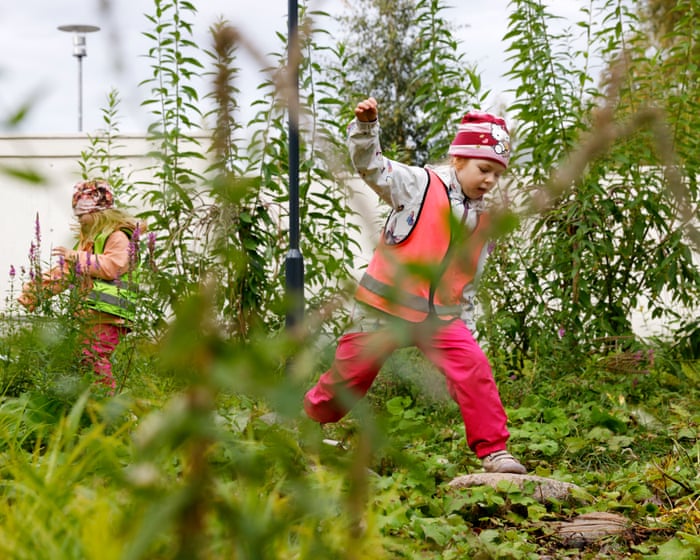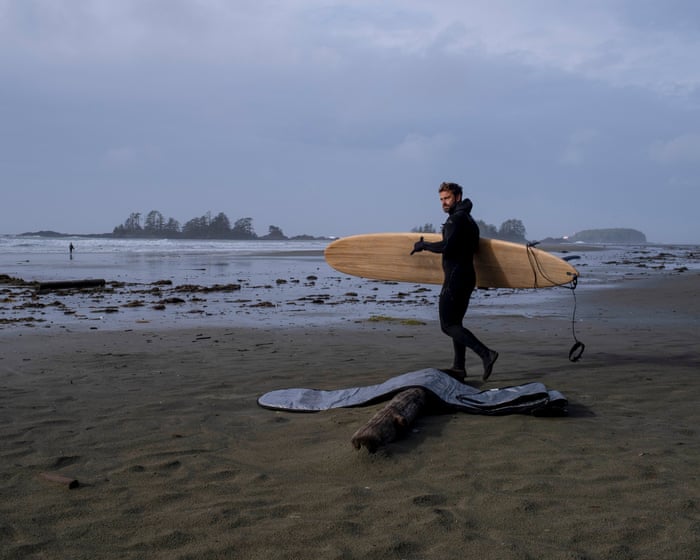Five-year-old Aurora Nikula is enjoying a typical day at her nursery. She’s busy making a pretend cake from sand and mud, mixing in imaginary carrots, potatoes, and meat. “It’s overcooked,” she announces while splashing water into her mixture, then adds another scoop of sand. “More sugar, it tastes better,” she declares, tossing in a handful of mud that transforms her creation into a chocolate cake.
Nearby, Aki Sinkkonen, a principal scientist from the Natural Resources Institute Finland, observes with interest. While he admires Aurora’s cake, his reasons are different from hers. “Perfect,” he remarks, watching her blend soil, sand, and leaves before smearing some on her face. “She’s really getting her hands in it.”
In a hygiene-focused kindergarten, this might be concerning, but at the Humpula daycare centre in Lahti, north of Helsinki, children are encouraged to play in the mud. Across Finland, 43 daycare centres have received a total of €1 million (£830,000) to naturalize their yards and boost children’s contact with the microscopic biodiversity—like bacteria and fungi—found in nature.
We already understand that outdoor access is vital for children’s development. This study, however, takes it a step further. It’s part of growing research connecting two layers of biodiversity: the outer layer, which includes the familiar elements of soil, water, plants, animals, and microbes in forests or playgrounds, and the inner layer, the biodiversity that inhabits and on our bodies, such as in our gut, skin, and airways.
Scientists are increasingly discovering that our health is deeply intertwined with our environment and the ecological well-being of the world around us. The first 1,000 days of life, when the brain and body develop most rapidly, are seen as especially critical.
At Humpula, this relationship is being explored through a unique experiment that involves bringing a piece of the forest floor into the daycare and observing how it affects the children’s health. In autumn, the centre—home to 180 children and 50 staff—resembles a child-run garden plot.
Compost, enriched with old leaves and weeds, is used to grow beetroots, carrots, cucumbers, potatoes, courgettes, and chillies. Now, with winter approaching, only parsley remains, as everything else has been eaten. Yet, the children continue to play outdoors.
The plants, dead wood, and soil at the daycare have been carefully chosen for their rich micro-biodiversity. They’ve also imported a large, live section of forest floor, 20-40cm deep and 10 meters square, complete with blueberries, lingonberries, and moss, to encourage foraging, bug hunting, and nature learning.
“This area hasn’t been forested for 200 years, so this is a substitute,” explains Sinkkonen. In a wetland area, children can balance on rocks and play among various plants—a space that was a gravel car park just five years ago.
This kindergarten participated in a two-year study examining how biodiversity improvements influence the microbial makeup of children’s skin, saliva, and feces. It was the first research of its kind. Blood samples were taken to assess immune defenses, and a brief questionnaire on infectious diseases was completed every three months. In total, 75 children aged three to five from 10 urban daycare centres were involved in the study.A study compared “rewilded” daycare centers with others that had surfaces like asphalt, sand, gravel, and plastic mats. After a year, children playing in the green kindergartens had fewer disease-causing bacteria, such as Streptococcus, on their skin and stronger immune systems. Their gut bacteria also showed lower levels of Clostridium, which is linked to inflammatory bowel disease, colitis, and infections like sepsis and botulism. Within 28 days, there was an increase in T regulatory cells in their blood, which help protect against autoimmune diseases. Other research found that playing in a sandpit enriched with garden soil improved children’s immune system regulation in just two weeks.
The human body hosts trillions of bacteria, viruses, and fungi that are essential for our functioning. Studies show that external microbes, like bacteria and fungi, enter the body through touch or ingestion. Even breathing plays a role, as the air has its own microbiome influenced by nearby trees and plants. Soil, which is home to 90% of the world’s fungi, also contributes to the air’s microbiome.
Scientists believe that one reason for the rise in allergies is that many people weren’t exposed to natural environmental microbes during childhood. The “old friends” hypothesis suggests that humans evolved alongside microbes in air, plants, and soil, and that our bodies interact with these microbes to maintain health.
Marja Roslund, a scientist at the Natural Resources Institute Finland, emphasizes the benefits for public health and the economy, noting that even a small reduction in immune diseases can have a positive impact.
While earlier research linked early exposure to green spaces with a healthy immune system, it wasn’t clear if this was a direct cause. The Finland study suggests it might be, and an Australian study from last year supported this, showing that children who played with various soils had better gut health and stronger immune systems.
The trend of incorporating nature into nurseries is growing. In Helsinki, the Poutapilvi-Puimuri daycare center is being redesigned with a €30,000 government grant. Currently under construction, it will soon feature trees, flowers, rocks, planters, sandpits, and a grassy play area. The center’s director, Marjo Välimäki-Saari, explains that they aim to bring activities outdoors and teach children about nature.
These kindergartens highlight how vital healthy ecosystems are for human health. As biodiversity and habitats decline worldwide, there could be significant consequences for human well-being. Enhancing biodiversity in these settings benefits both children’s health and the environment.
Research from the University of Sheffield has explored using green barriers around school playgrounds to reduce air pollution. At Hunter’s Bar Infant School in Sheffield, a 70-meter-long hedge of plants and shrubs was planted around the playground near a busy road. Six months after planting, nitrogen dioxide levels in the playground dropped by 13%, with further reductions expected as the hedge grows.View the image in fullscreen.
Marjo Välämäki-Saari, the director of Poutapilvi-Puimuri daycare center, assists Mikael (on the right) and Eero in searching for apples.
“An increasing number of people are expressing interest in establishing similar daycares in their own towns,” Roslund notes. Delegations from Norway, Iceland, and Denmark have visited to explore how they might adapt the Finnish approach locally. Sinkkonen adds, “I hope to see rubber mats eliminated from all kindergartens.”
For additional coverage on environmental issues, visit our Age of Extinction section. Stay updated on biodiversity news by following reporters Phoebe Weston and Patrick Greenfield in the Guardian app.
Frequently Asked Questions
Of course Here is a list of helpful FAQs about introducing a forest into a preschool setting
General Beginner Questions
1 What does a forest preschool actually mean
Its a preschool where children spend a significant amount of their learning time outdoors in a natural forestlike environment regardless of the weather
2 What are the main benefits for the children
Studies show major improvements in physical health social skills creativity resilience and emotional wellbeing Children become more confident cooperative and less stressed
3 Isnt it unsafe for young children to be in a forest all day
Safety is the top priority These are not wild unsupervised areas They are carefully managed spaces with trained staff clear boundaries and thorough risk assessments to minimize hazards
4 What do children even do out there all day
They learn through play This includes building forts climbing logs identifying insects making mud pies storytelling and exploringall of which teach valuable lessons about nature physics and teamwork
5 What about when the weather is bad
Children are equipped with proper gear to enjoy all seasons The philosophy is theres no bad weather only unsuitable clothing A simple shelter is often available for extreme conditions
Advanced Practical Questions
6 How does outdoor play specifically improve wellbeing
Contact with nature reduces cortisol and increases feelings of calm The unstructured play also fosters independence problemsolving skills and a sense of wonder that indoor classrooms cant always replicate
7 What are the biggest challenges in starting a forest preschool
Common challenges include securing a suitable outdoor space getting buyin from worried parents navigating licensing regulations and ensuring staff are trained in outdoor pedagogy and risk management
8 Dont children fall behind on academic skills like reading and math
No the opposite often happens Forest schools naturally integrate foundational math preliteracy and scientific reasoning The focus on executive functions like concentration prepares them brilliantly for formal academics
9 Can a traditional preschool incorporate some of these ideas without going fully outdoors
Absolutely Many schools create a forest school day once a week establish a natural playscape in their existing yard or simply bring more natural materials sticks stones pinecones




